Apple iPhone 4S: Thoroughly Reviewed
by Anand Lal Shimpi & Brian Klug on October 31, 2011 7:45 PM EST- Posted in
- Smartphones
- Apple
- Mobile
- iPhone
- iPhone 4S
Faster Throughput on WCDMA
Fixing unintended attenuation is only one part of what’s new however, the other part of the story is faster cellular connectivity for users on WCDMA/UMTS carriers. Users who are using the 4S on CDMA (like Sprint or Verizon) won’t see a performance difference since this is still the same EVDO Rev.A.
The iPhone 4 used an Intel/Infineon X-Gold 618 which supported HSDPA 7.2 and HSUPA 5.76. The MDM6610 inside the 4S supports HSDPA 14.4 and HSUPA 5.76, alongside a number of 3GPP Rel.7 features which are colloquially known as HSPA+. I talked about this extensively in another piece when there was some confusion about whether or not the 4S is HSPA+ - which it is.
| iPhone Cellular Speeds | ||||
| Property | iPhone 3G/3GS | iPhone 4 (GSM/UMTS) | iPhone 4 (CDMA) | iPhone 4S |
| Baseband | Infineon X-Gold 608 | Infineon X-Gold 618 | Qualcomm MDM6600 | Qualcomm MDM6610 |
| HSDPA | Cat.8 - 7.2 Mbps | Cat.8 - 7.2 Mbps | N/A | Cat.10 - 14.4 Mbps |
| HSUPA | None - 384 Kbps WCDMA only | Cat.6 - 5.76 Mbps | N/A | Cat.6 - 5.76 Mbps |
| EVDO | N/A | N/A | 1x/EVDO Rev.A | 1x/EVDO Rev.A |
The previous X-Gold 618 baseband was a nice improvement over the iPhone 3G/3GS’ X-Gold 608, which lacked HSUPA, but in a world where most WCDMA carriers are at least running HSDPA 14.4, it’s nice to finally have an iPhone with something faster than HSDPA 7.2. I’ve done lots of testing inside my Tucson, AZ market (which is “4G” HSPA+ on AT&T’s coverage viewer) with both the 4 and the 4S, and have built a very good feel for the 4’s performance. As a reminder, if you’re in the USA, those dark blue areas represent HSPA+ coverage areas with AT&T’s upgraded backhaul. In practice these are at least HSDPA 14.4.

Left: iPhone 4 Limited to ~6.1 Mbps down, Right: iPhone 4S (same location) hitting ~9 Mbps
With line of sight to an AT&T NodeB inside my HSPA+ market I’m used to seeing a maximum downstream throughput on the iPhone 4 of almost exactly ~6.1 Mbps, which is about right for the 4’s HSDPA 7.2 maximum when you include overhead. The nice straight line in that result should clue you in that downstream throughput on the 4 was being gated by the baseband. On the 4S, in this same location, I’ve been able to get 9.9 Mbps when the cell isn’t loaded at night (I didn't grab a screenshot of that one, for some reason). It’s nice to finally not be gated by the baseband anymore on an iDevice. Having a faster baseband is part of the reason the 4S’s cellular performance is much better, the other half is receive diversity which helps the 4S push these high throughput rates, and also dramatically improve performance at cell edge.
I did some drive testing with the 4 and 4S side by side and targeted areas that I know have pretty poor signal strength. The 4S is shown in yellow, the 4 in blue.
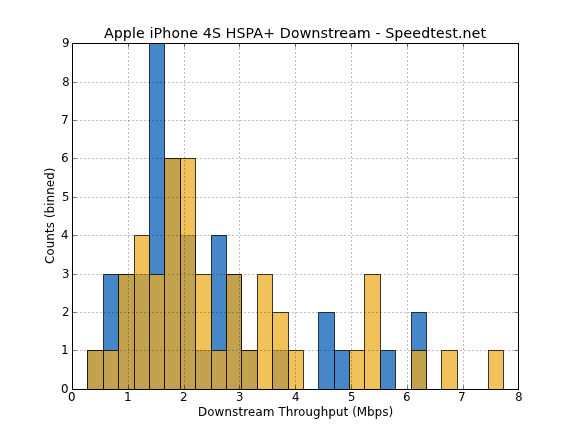
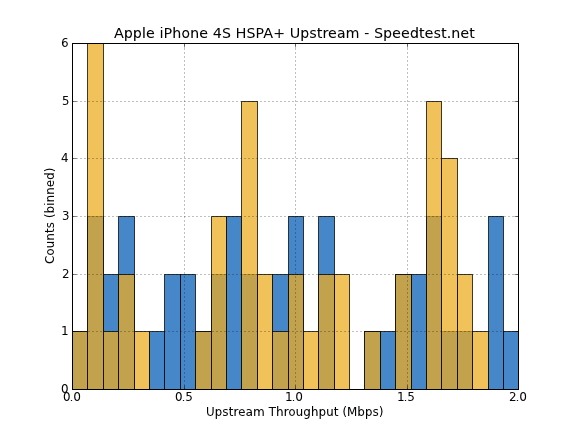
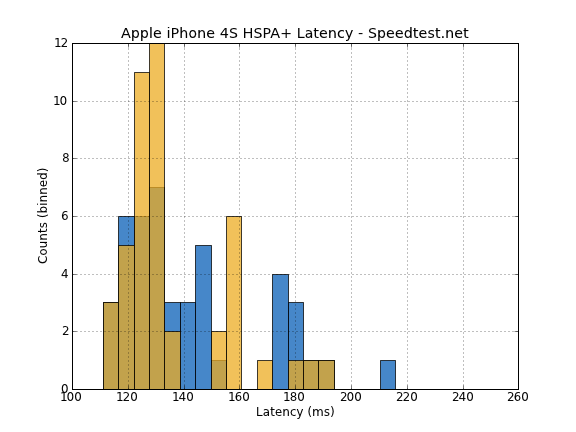
You can see how downstream throughput gets a nice shift up, and the average changes as well, from 2.28 Mbps on the 4 to 2.72 Mbps on the 4S. The maximum in this sample increases from 6.25 to 7.62 Mbps as well. It isn’t a huge shift, but subjectively I’ve noticed the 4S going a lot faster in areas that previously were difficult for the 4.
We’ve also run the usual set of standalone tests on the 4S on AT&T in my market of Tucson, AZ, in Anand’s market of Raleigh, NC, and on Verizon in Raleigh, NC. Though we don’t have a Sprint 4S yet, we hope to do a more serious 4S carrier comparison here in the US when we get one. First up is AT&T which is of course HSPA+ in both of our testing markets.
AT&T HSPA+
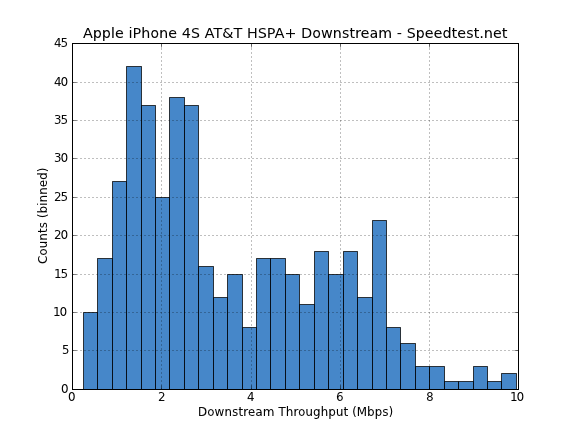
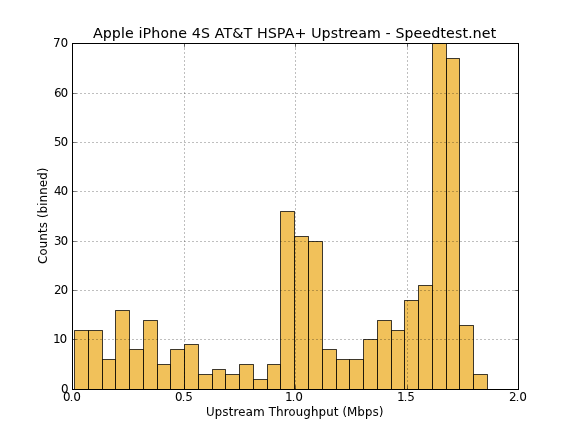

Verizon EVDO
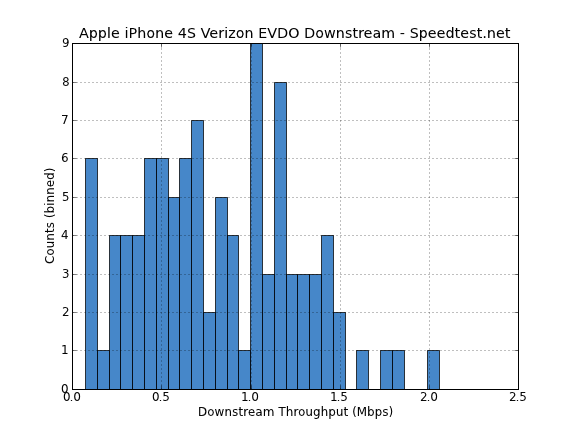
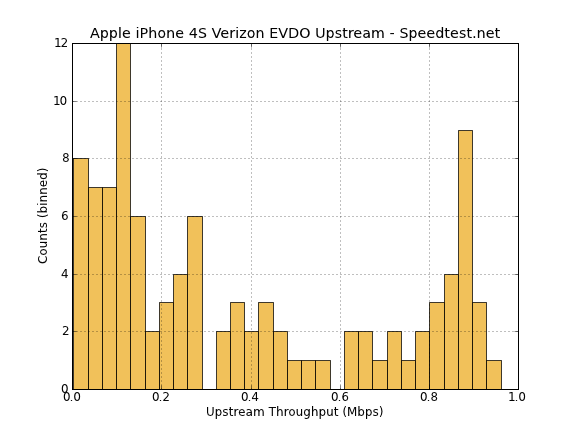

| iPhone 4S Speedtest Comparison | ||||||
| Carrier | AT&T | Verizon | ||||
| Avg | Max | Min | Avg | Max | Min | |
| Downstream (Mbps) | 3.53 | 9.94 | 0.24 | 0.82 | 2.05 | 0.07 |
| Upstream (Mbps) | 1.17 | 1.86 | 0.009 | 0.38 | 0.96 | 0.003 |
| Latency (ms) | 137 | 784 | 95 | 177 | 1383 | 104 |
| Total Tests | 457 | 150 | ||||
| Air Interface |
HSPA+ (HSDPA 14.4/HSUPA 5.76) |
EVDO Rev.A | ||||
For the CDMA carriers, the 4S shouldn’t (and doesn’t) bring any huge improvement to data throughput because the CDMA 4 had both receive diversity and MDM66x0. For users on GSM/UMTS, however, the 4S does make a difference again thanks to the inclusion of those two new features.
One of the things I noticed was absent on the CDMA iPhone 4 was the 3G toggle. It does indeed make some sense to not include this in a CDMA 1x/EVDO scenario since power draw is about the same between the two air interfaces, however, the absence of this toggle has carried over to the 4S regardless of whether the phone is activated on a CDMA2000 or UMTS/GSM network. That’s right, you can go under Settings -> General -> Network, and there’s no longer any 3G Data toggle which you can disable and fall onto EDGE (2G) with now.
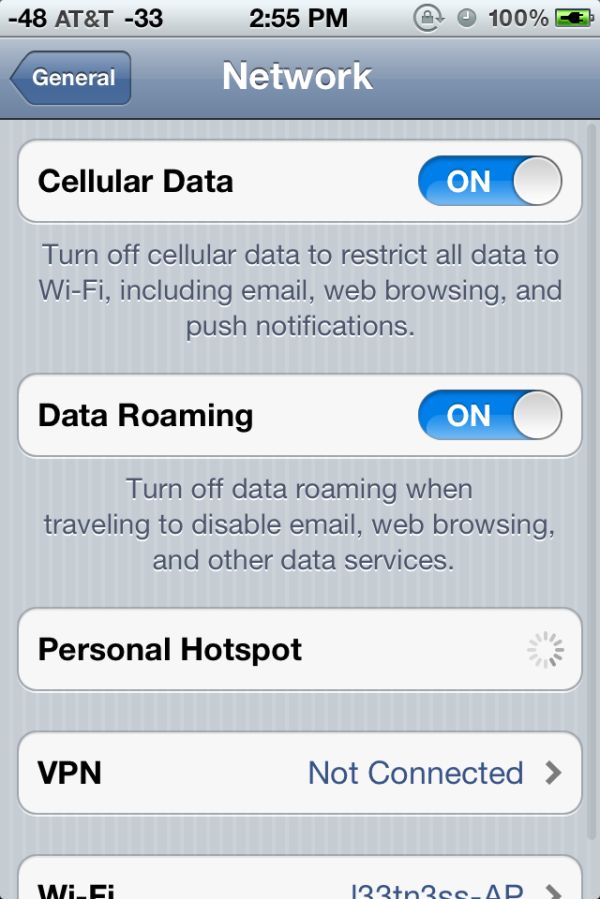
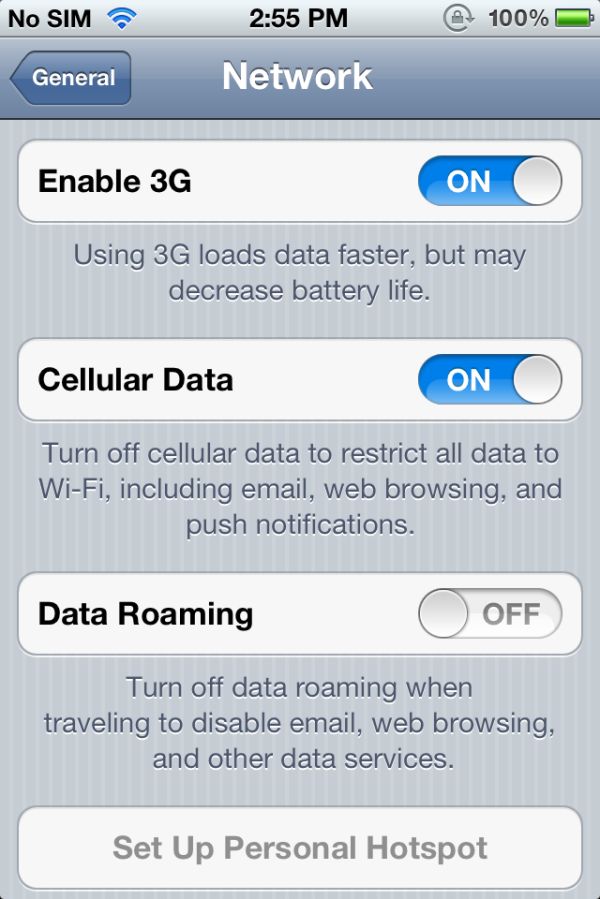
Left: iPhone 4S (no 3G toggle), Right: iPhone 4 (3G toggle)
It’s likely that this is absent to accommodate the multi-mode nature of the 4S (and thus the lowest common denominator CDMA mode), however the absence of this toggle makes getting connected in congested areas more difficult. In some markets, (I’m looking at you, AT&T in Las Vegas), EDGE is often the only way to get any connectivity, even without a major convention going on. Not having that 3G toggle makes manually selecting that less-used but more reliable connection impossible now, to say nothing of the potential battery savings that this would afford (and that we sadly can’t test now).
There’s one last tangential question about HSPA+ on the 4S, specifically on AT&T. I’ve left this to the end since it doesn’t impact non-US 4S users, but the last question is whether the 4S is actually on HSPA+. For a while, I was concerned that AT&T would continue using the wap.cingular APN on the 4S which seems shaped to around 7.2 Mbps HSDPA. I’m glad to report that AT&T hasn’t continued using wap.cingular on its 4S data plans, instead using “phone” which is a newer APN that allows for HSPA+ (above 7.2 Mbps) rates. You can check this yourself under PDP Context Info on the 4S in field test.


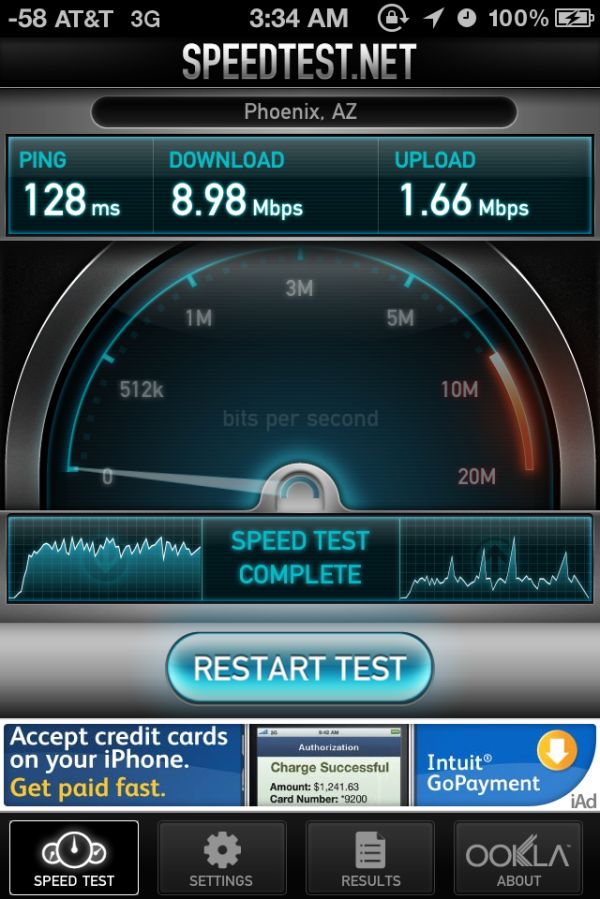
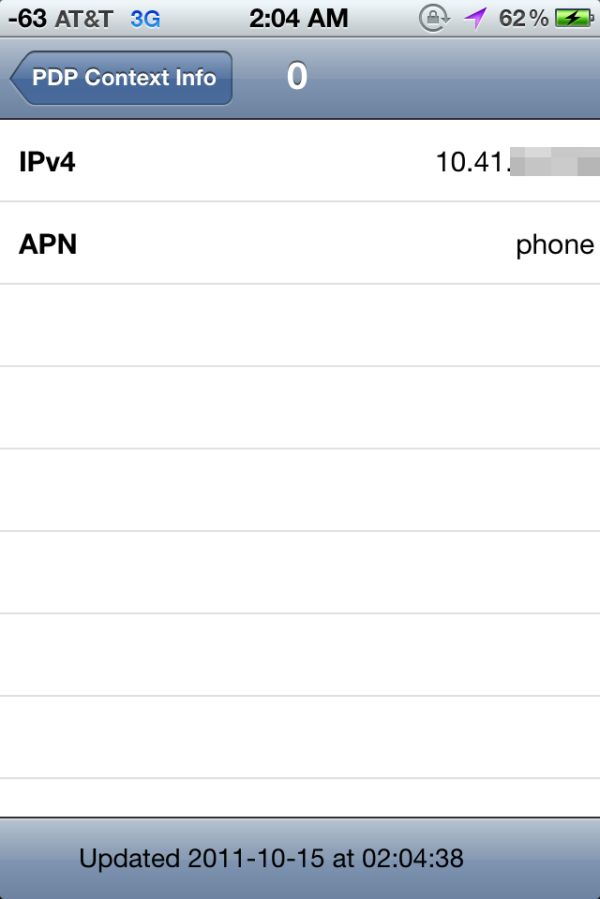








199 Comments
View All Comments
dacramer - Tuesday, November 1, 2011 - link
The browser benchmarks show the 4s as fastest, but this benchmark is FLAWED as a measurement of CPU performance.The benchmark compares Safari to the Android stock browser. The stock Android browser does not support 2 cores, only 1. So all Android dual cores phones would be nearly twice as fast with another browser such as Opera.
I'm surprised Anand did not include this discussion in the review. He seams fixated on the idea that stock to stock browser is a valuable comparison when it totally misleads readers on CPU performance.
Lucian Armasu - Wednesday, November 2, 2011 - link
In case you missed it, the Droid RAZR scored 10% faster than iPhone 4S in the SunSpider test.But yes, this is still mostly a software issue, and I expect the Android 4.0 browser to be even faster on the same chip.
thunng8 - Wednesday, November 2, 2011 - link
FYI, Google says the Galaxy Nexus scores 1983ms in Sunspider running ICSdoobydoo - Wednesday, November 2, 2011 - link
"Where did it show faster CPU?"Where did it in my comment?
Breit - Thursday, November 3, 2011 - link
I just run SunSpider 0.9.1 on my Galaxy S2, international model (everything stock, with Android 2.3.5) and it came in at 1626.5ms with Opera Mobile browser and 3354.8ms with the stock Android browser. So saying the CPU on the Galaxy S2 is weaker than the CPU on the 4S is just not right (and that by a big margin!).At least make comparisons with the best software there is and not just 'some' browser you eventually found on your phone...
I'll bet there is someone programming his own browser just for the kicks or as an exercise for his programming skills and that browser scores over 9000ms in SunSpider. Does that mean the CPU in that phone is slow? ;)
doobydoo - Friday, December 2, 2011 - link
You could achieve the same results on the iPhone too..The comparison is (rightly) comparing stock browser to stock browser, and the iPhone 4S is faster. It would be even faster again using say, Opera.
As for some guy posting 9000ms - you can filter the results to 'best' times so this is a non issue.
Tetracycloide - Tuesday, November 1, 2011 - link
Isn't there more to displays than just white level in nits, black level in nits (on a chart were I can't seem to find the Galaxy S II or the Infuse), and contrast (again, don't see the Samsung Galaxy S II or the Infuse on the contrast chart either)? Don't get me wrong, I don't agree in the slightest with the summary "this is apple cheerleading" but honestly the display comparisons are pretty lacking IMO. Where are the rest of them? There's more to a screen than just nits.medi01 - Thursday, November 3, 2011 - link
Last time iphone disappeared from comparison photo, from the one where it would pale in comparison, when asked, author "explained' that he simply "forgot" it in the pocket. (!!!). Now they didn't even bother. Round of but kissing on "retina" hype and phones disappearing from charts.Find contrast of Galaxy phones on the charts pretty please...
steven75 - Friday, November 11, 2011 - link
Could you be any more of an Fandroid? Seriously.Stuka87 - Tuesday, November 1, 2011 - link
Wait what?Almost every single page has a comparison to Android phones. Several of them have graphs showing the differences!
And your comment on the displays may be your opinion, but actual measurements show otherwise. but hey, if you like your over saturated display with a much lower pixel density, thats your decision.